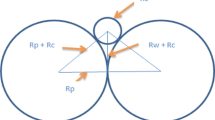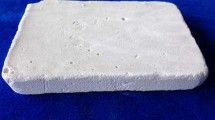Abstract
In this work, the electrical and thermal conductivities of open-cell porous aluminium materials produced by replication casting method are investigated and the correlations between them studied. The four-point probe method was used to measure the electrical conductivity of the samples, while the C-therm analyser was used to experimentally determine the thermal conductivity of the cellular materials. The results show that both electrical and thermal conductivities of the porous samples increase as their relative density is increased. Comparison of the measured data with theoretical models shows that the scaling function with a dynamic exponent equal to 1.55 fits the experimental data for electrical conductivity. In addition, an empirical relationship was found to exist between measured electrical and thermal conductivities, while a modified Wiedemann-Franz law was also deduced to correlate the electrical and thermal conductivities of the porous aluminium materials.











Similar content being viewed by others
Data availability
The authors confirm that the data supporting this study’s conclusions is included in the publication.
References
Sriharsha SS, Wei L (2014) The effect of pore size and porosity on thermal management performance of phase change material infiltrated microcellular metal foams. Appl Therm Eng 64:147–154
Hoshi A, Mills DR, Bittar A, Saitoh TS (2005) Screening of high melting point phase change materials (PCM) in solar thermal concentrating technology based on CLFR. Sol Energy 79(3):332–339
Shama A, Tyagi VV, Chen CR, Buddhi D (2009) Review on thermal energy storage with phase change materials and applications. Renew Sust Energ Rev 13(2):318–345
Tyagi VV, Buddhi D (2007) PCM Thermal storage in buildings: a state of the art. Renew Sust Energ Rev 11(6):1146–1166
Ahn S, Kim Y, Kim KJ, Kim TH, Lee H, Kim M (1991) H, Development of high capacity, high rate lithium ion batteries utilizing metal fiber conductive additive. J Power Sources 81:896–901
Jiang T, Zhang SC, Qiu XP, Zhu WT, Chen IQ (2007) Preparation and characterization of tin-based three-dimensional cellular anode for lithium ion battery. J Power Sources 166:503–508
Liu PS, Li TF, Fu C (1999) Relationship between electrical resistivity and porosity for porous metals. Mater Sci Eng A 268:208–215
Zaragoza G, Goodall R (2013) Metal foam with graded pore size for heat transfer applications. Adv Eng Mater:123–128. https://doi.org/10.1002/adem/201200166
Maiorano LP, Molina J (2018) M, Challenging thermal management by incorporation of graphite into aluminium foams. Mater Des 158:160–171
Maiorano LP, Molina JM (2020) Guiding heat in active thermal management: one pot incorporation of interfacial nano-engineered aluminium/diamond composites into aluminium foams, Composites Part A. Appl Sci Manuf 133. https://doi.org/10.1016/j.compositesa.2020.105859
Durmus FC, Maiorano LP, Molina JM (2022) Open-cell aluminium foam with bimodal pore distributions for emerging thermal management applications. Int J Heat Mass Transf 191. https://doi.org/10.1016/j.ijheatmasstransfer.2022.122852
Abuserwal AF, Elizondu Luna EM, Goodall R (2017) The effective thermal conductivity of open cell replicated aluminium metal sponges. Int J Heat Mass Transf 108:1439–1448
Yang X (2013) A simplified analytical unit cell based model for the effective thermal conductivity of high porosity open-cell metal foams. J Appl Phys 46:26
Mendes MA, Ray S, Trimis D (2014) An improved model for the effective thermal conductivity of open-cell porous aluminium. Int J Heat Mass Transf 75:224–230
Bhattacharya A, Calmidi VV, Mahajan RN (2002) Thermo physical properties of high porosity foams. Int J Heat Mass Transf 45:1017–1031
Cuevas FG, Montes JM, Cintas J, Urban P (2009) Electrical conductivity and porosity relationship in metal foams. J Porous Mater 16:675–681
Feng Y, Zheng H, Zhu Z, Zu F (2002) The microstructure and electrical conductivity of aluminium alloy foams. Mater Chem Phys 78:196–201
Goodall R, Weber L (2006) Mortensen, A, The electrical conductivity of microcellular metals. J Appl Phys 100:126–137
Hucheng P, Fusheng P, Xiao W, Aitao T (2013) Correlation on the electrical and thermal conductivity for binary Mg-Al and Mg-Zn alloys. Int J Thermophys 34:1336–1346
Aksoz S, Ocak Y, Marasli N, Cadirli E, Kaya H, Boyuk U (2010) Dependency of the thermal and electrical conductivity on the temperature and composition of Cu in the Al based Al-Cu alloys. Exp Thermal Fluid Sci 34:1507–1516
Jinnapat A (2011) The manufacture and characterisation of aluminium foams made by investment casting using dissolvable sodium chloride beads preforms. PhD Thesis,. University of Nottingham, Nottingham, UK
Dharmasena KP, Wadley HNG (2002) Electrical conductivity of open-cell metal foams. J Mater Res 17(3):625–631
Zhou W, Tang Y, Song R, Jiang L, Hui KS, Hui KN (2012) Characterization of electrical conductivity of porous metal fiber sintered sheet using four-point probe method. Mater Des 37:161–167
Bai M, Chung JN (2011) Analytical and numerical prediction of heat transfer and pressure drop in open-cell metal foams. Int J Therm Sci 50:869–880
Accessed online from www.efunda.com/materials/elements/TC_Table.cfm?Element_ID=Al on April 30, 2015.
Lemlich R (1978) A Theory for the limiting conductivity of polyhedral foam at low density. J Colloid Interface Sci 64:107–110
Liu PS, Liang KM (2000) Evaluating electrical resistivity for high porosity metals. Mater Sci Technol 16:341
Langlois S, Couret F (1989) Flow-through and flow-by porous electrodes of nickel foam. J Appl Electrochem 47:1489–1491
Ashby MF, Evans A, Fleck NA, Gibson LJ, Hutchinson JW, Wadley HN (2000) Metal foam- a design guide. Butterworth Heinmann
Huang XL, Wu GH, Zhang Q, Kang PC, Leng JF (2009) Electrical conductivity of open-cell Fe-Ni alloy foam. J Alloys Compd 479:898–901
Liu PS, Li TF, Fu C (1999) Relationship between electrical resistivity and porosity. Mater Sci Eng 268:208–215
Kittle C (2005) Introduction to solid state physics. John Wiley and Sons
Wan T, Liang G, Wang Z et al (2022) Fabrication and compressive behavior of open-cell aluminum foams via infiltration casting using spherical CaCl2 space-holders. China Foundry 19:89–98. https://doi.org/10.1007/s41230-022-1159-2
Funding
The Tertiary Education Trust Fund (TETFUND), Nigeria, provided funds for this research work.
Author information
Authors and Affiliations
Contributions
All contributed 100% to the study’s development, from experimentation to analysis.
Corresponding author
Ethics declarations
Acceptance of ethics
Because this experiment does not involve people or animals, no ethics committee approval is required.
Consent of participants
Because this study does not include people or animals, no permission is required to participate.
Consent for publication
The authors give the publisher the consent to publish the work.
Competing interests
The authors declare no competing interests.
Additional information
Publishing permission
The writers grant their permission for the work to be published by the publisher.
Publisher’s note
Springer Nature remains neutral with regard to jurisdictional claims in published maps and institutional affiliations.
Rights and permissions
Springer Nature or its licensor (e.g. a society or other partner) holds exclusive rights to this article under a publishing agreement with the author(s) or other rightsholder(s); author self-archiving of the accepted manuscript version of this article is solely governed by the terms of such publishing agreement and applicable law.
About this article
Cite this article
Egwuonwu, N.R., Boniface, O.O. & Sunday, A.V. Unveiling empirical correlation between electrical and thermal conductivities of medium porosity open-cell porous aluminium fabricated by replication casting method. Int J Adv Manuf Technol 131, 3499–3507 (2024). https://doi.org/10.1007/s00170-024-13230-6
Received:
Accepted:
Published:
Issue Date:
DOI: https://doi.org/10.1007/s00170-024-13230-6




